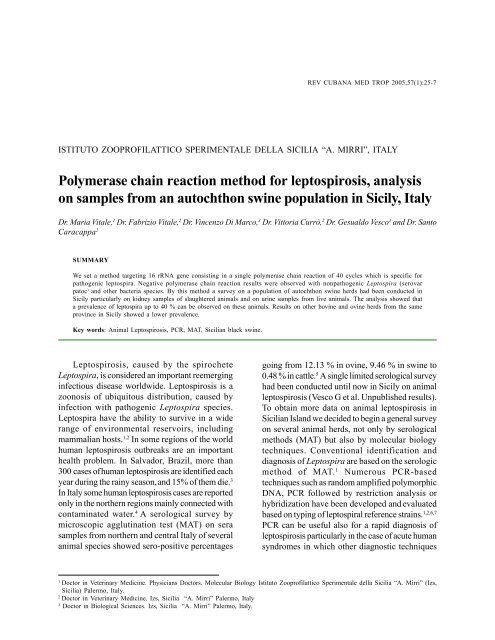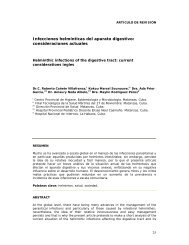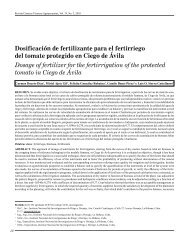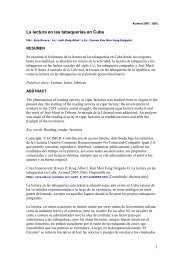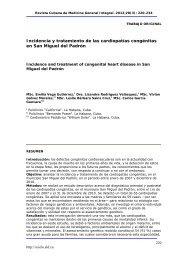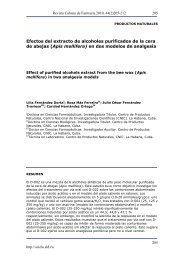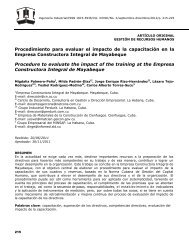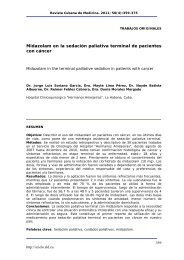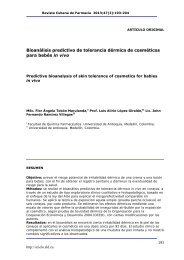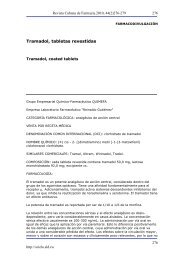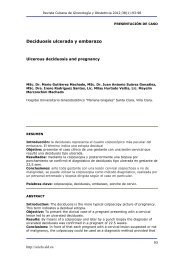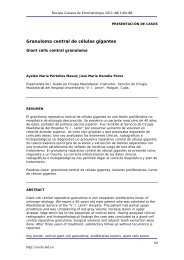Polymerase chain reaction method for leptospirosis ... - SciELO
Polymerase chain reaction method for leptospirosis ... - SciELO
Polymerase chain reaction method for leptospirosis ... - SciELO
Create successful ePaper yourself
Turn your PDF publications into a flip-book with our unique Google optimized e-Paper software.
ISTITUTO ZOOPROFILATTICO SPERIMENTALE DELLA SICILIA “A. MIRRI”, ITALY<br />
<strong>Polymerase</strong> <strong>chain</strong> <strong>reaction</strong> <strong>method</strong> <strong>for</strong> <strong>leptospirosis</strong>, analysis<br />
on samples from an autochthon swine population in Sicily, Italy<br />
Dr. Maria Vitale, 1 Dr. Fabrizio Vitale, 2 Dr. Vincenzo Di Marco, 3 Dr. Vittoria Currò, 2 Dr. Gesualdo Vesco 3 and Dr. Santo<br />
Caracappa 2<br />
SUMMARY<br />
We set a <strong>method</strong> targeting 16 rRNA gene consisting in a single polymerase <strong>chain</strong> <strong>reaction</strong> of 40 cycles which is specific <strong>for</strong><br />
pathogenic leptospira. Negative polymerase <strong>chain</strong> <strong>reaction</strong> results were observed with nonpathogenic Leptospira (serovar<br />
patoc ) and other bacteria species. By this <strong>method</strong> a survey on a population of autochthon swine herds had been conducted in<br />
Sicily particularly on kidney samples of slaughtered animals and on urine samples from live animals. The analysis showed that<br />
a prevalence of leptospira up to 40 % can be observed on these animals. Results on other bovine and ovine herds from the same<br />
province in Sicily showed a lower prevalence.<br />
Key words: Animal Leptospirosis, PCR, MAT, Sicilian black swine.<br />
Leptospirosis, caused by the spirochete<br />
Leptospira, is considered an important reemerging<br />
infectious disease worldwide. Leptospirosis is a<br />
zoonosis of ubiquitous distribution, caused by<br />
infection with pathogenic Leptospira species.<br />
Leptospira have the ability to survive in a wide<br />
range of environmental reservoirs, including<br />
mammalian hosts. 1,2 In some regions of the world<br />
human <strong>leptospirosis</strong> outbreaks are an important<br />
health problem. In Salvador, Brazil, more than<br />
300 cases of human <strong>leptospirosis</strong> are identified each<br />
year during the rainy season, and 15% of them die. 3<br />
In Italy some human <strong>leptospirosis</strong> cases are reported<br />
only in the northern regions mainly connected with<br />
contaminated water. 4 A serological survey by<br />
microscopic agglutination test (MAT) on sera<br />
samples from northern and central Italy of several<br />
animal species showed sero-positive percentages<br />
25<br />
REV CUBANA MED TROP 2005;57(1):25-7<br />
going from 12.13 % in ovine, 9.46 % in swine to<br />
0.48 % in cattle. 5 A single limited serological survey<br />
had been conducted until now in Sicily on animal<br />
<strong>leptospirosis</strong> (Vesco G et al. Unpublished results).<br />
To obtain more data on animal <strong>leptospirosis</strong> in<br />
Sicilian Island we decided to begin a general survey<br />
on several animal herds, not only by serological<br />
<strong>method</strong>s (MAT) but also by molecular biology<br />
techniques. Conventional identification and<br />
diagnosis of Leptospira are based on the serologic<br />
<strong>method</strong> of MAT. 1 Numerous PCR-based<br />
techniques such as random amplified polymorphic<br />
DNA, PCR followed by restriction analysis or<br />
hybridization have been developed and evaluated<br />
based on typing of leptospiral reference strains. 1,2,6,7<br />
PCR can be useful also <strong>for</strong> a rapid diagnosis of<br />
<strong>leptospirosis</strong> particularly in the case of acute human<br />
syndromes in which other diagnostic techniques<br />
1 Doctor in Veterinary Medicine. Physicians Doctors. Molecular Biology Istituto Zooprofilattico Sperimentale della Sicilia “A. Mirri” (Izs,<br />
Sicilia) Palermo, Italy.<br />
2 Doctor in Veterinary Medicine. Izs, Sicilia “A. Mirri” Palermo, Italy<br />
3 Doctor in Biological Sciences. Izs, Sicilia “A. Mirri” Palermo, Italy.
26<br />
can give negative results or are anyway timeconsuming.<br />
1,2 Previously analysis had shown that<br />
PCR targeting 16S rRNA gene had a high sensitivity,<br />
(M. Vitale et al. unpublished observation). In this paper<br />
we focused particularly on the analysis of an<br />
autochthon swine population (black swine of Nebrodi)<br />
which lives freely in the woods, in conditions very<br />
similar to the wild status. The black swine of Nebrodi<br />
also called Sicilian is an autochthon Sicilian race of<br />
very ancient origin. Today is present in a limited<br />
number of animals in Madonie (Palermo) and Nebrodi<br />
(Messina) mountains.<br />
METHODS<br />
Isolation has been made from urine samples<br />
immediately put on EMJH containing 5-fluoroacil<br />
at 100 micrograms/ml; kidney samples were<br />
homogenized in the same medium and then<br />
incubated as described in OIE manual. 8<br />
Molecular analysis: DNA was extracted from<br />
kidney and liver samples using Fast DNA Kit from<br />
Q BIO GENE and Rybolyser Homogenization<br />
according to manufacture’s instructions.<br />
DNA from urine samples was extracted using<br />
2 aliquots of 200 microliters of urine with Qiagen<br />
columns following the manufacture’s protocol<br />
without any further treatment; at the end we put<br />
together the 2 aliquots and per<strong>for</strong>m PCR on 16S<br />
rRNA gene. PCR analysis had been per<strong>for</strong>med<br />
using 16S rRNA gene as PCR target (primers:<br />
LEPTO E1 GGGAAAAATAAGCAGCGATGTG<br />
and LEPTO E2-ATTCCACTCCATGTCAAGCC<br />
amplicon 571 bp). 9<br />
The following program in the Applied<br />
Biosystem 9 700 thermal cycler was used: 94 °C<br />
<strong>for</strong> 5 minutes 1 cycle followed by 40 cycles at<br />
1 minute at 94 °C, 1 minute at 60 °C, 1 minute<br />
at 72 °C. The final extension was at 72 °C<br />
<strong>for</strong> 5 minutes.<br />
DNA from the bacterial strains was extracted<br />
by Qiagen column affinity column.<br />
The amplified fragments were visualised on<br />
2 % agarose gel.<br />
RESULTS<br />
PCR <strong>method</strong> targeting 16S rRNA gene on<br />
DNA extracted from tissue and urine samples<br />
resulted in a high specific analytic <strong>method</strong> as<br />
shown in figure; pathogen Leptospira spp. were<br />
detected while several other bacteria species<br />
were negative.<br />
We per<strong>for</strong>med analysis on different samples<br />
(urine, tissues) from black swine of Nebrodi to look<br />
<strong>for</strong> a prevalence of <strong>leptospirosis</strong>. In this population<br />
of animals we found PCR positive animals in a<br />
high percentage up to 40% (Table 1).<br />
The animals were coming from a restricted<br />
area in province of Messina in north-east of Sicily<br />
in which are located almost 15 herds of these swine<br />
with a total population of 900 animals. Black swine<br />
are particularly interesting because they live in<br />
conditions that are very similar to wild animals and<br />
so they can give a better idea of the diffusion of<br />
the micro-organism in natural environment.<br />
Survey on tissue and urine samples in bovine<br />
and ovine herds coming from the same areas in<br />
Fig. PCR results on 1. L.pomoma;<br />
2. L.grippothiphosa; 3. L.ballum;<br />
4. E.coli; 5. B. melitensis; 6. S. aureus;<br />
7. L. patoc; 8. S. abortus ovis; 9. M.<br />
bovis; 10. L. infantum; K-no DNA<br />
tamplate; M-100bp ladder.
Sicily showed a lower percentage of PCR and<br />
isolation positive animals (Table 2).<br />
TABLE 1. PCR and isolation data on samples from Black swine<br />
of Nebrodi<br />
Kidney PCR + 30/90 33 %<br />
Isolation + 8/90 8,8 %<br />
Urine PCR + 28/70 40 %<br />
Isolation + 15/70 21 %<br />
Liver PCR + 5/13 38 %<br />
Isolation + 0/13<br />
TABLE 2. PCR and isolation data from bovine and ovine samples<br />
in Messina province<br />
Bovine Ovine<br />
Kidney PCR + 3/60 (5 %) 3/45 (6,6 %)<br />
Isolation + 0/60 0/45<br />
Urine PCR + 5/60 (8,3 %) 3/60 (5 %)<br />
Isolation + 0/60 0/60<br />
DISCUSSION<br />
The PCR targeting 16S rRNA gene can be a<br />
useful tool <strong>for</strong> the rapid diagnosis of <strong>leptospirosis</strong><br />
detecting specifically many pathogenic leptospira.<br />
We found that the <strong>method</strong> is quite specific and<br />
analysis on DNA extracted by tissue samples and<br />
urine gave a higher number of positive animals<br />
compared to the isolation procedures. A previous<br />
serological screening on 110 bovine herds in southeast<br />
Sicily had shown by MAT a prevalence of<br />
hardjo serovar up to 29 % on positive farms (Vesco<br />
G et al. Unpublished results). Considering that a<br />
high percentage of bovine herds (36 %) resulted<br />
positive by this <strong>method</strong>, we decided to plan a new<br />
survey to cover the entire island with analysis on<br />
different animals. The epidemiological data on<br />
animal <strong>leptospirosis</strong> in Messina province in Sicily<br />
showed a high positive percentage by PCR in a<br />
population of autochthon swine race (black swine<br />
of Nebrodi) while data on other animal herds in<br />
the same province showed a lower percentage of<br />
positive samples by PCR. The black swine of<br />
Nebrodi are freely living in the woods and they are<br />
put in restricted area only <strong>for</strong> a short period right<br />
be<strong>for</strong>e slaughtering, so it is possible that the higher<br />
prevalence is due to their wild living conditions.<br />
ACNOWLEDGEMENTS<br />
The authors thank to M. Piazza, M. Leonardi<br />
and A. Fascetto <strong>for</strong> their technical assistance. The<br />
27<br />
work was financed by a grant to M.Vitale “Ricerca<br />
corrente 2001” from the Italian Ministry of Health.<br />
Método de reacción en cadena de la polimerasa para la<br />
<strong>leptospirosis</strong>, análisis en muestras de una población<br />
autóctona de cerdos en Sicilia, Italia<br />
RESUMEN<br />
Se fijó un método que apuntó al gen del rRNA 16S, que consistió<br />
en una sola reacción en cadena de la polimerasa de 40 ciclos que<br />
es específica para leptospiras patógenas. Los resultados negativos<br />
de la reacción en cadena de la polimerasa fueron observados en<br />
leptospiras no-patogénicas (serovar patoc) y en otras especies<br />
de bacterias. Un estudio en una población de manadas de cerdos<br />
autóctonos en Sicilia se realizó por este método, particularmente<br />
en muestras de riñón de animales sacrificados y en muestras de<br />
orina de animales vivos. El análisis demostró una prevalencia de<br />
leptospiras de 40 % en estos animales. En otra manada de bovinos<br />
y ovinos, en la misma provincia de Sicilia, se encontró una baja<br />
prevalencia.<br />
Palabras clave: Leptospirosis animal, RCP, MAT, cerdos negros<br />
de Sicilia.<br />
REFERENCES<br />
1. Faine S, Adler B, Bolin C, Perolat P. Leptospira and<br />
<strong>leptospirosis</strong>l 2nd ed. Melbourne:MediSci;1999.<br />
2. Levett PN. Leptospirosis. Clin Microbiol Rev<br />
2001;14:296-326.<br />
3. Ko AI, Reis MG, Dourado CR, Johnson WD, Riley LW.<br />
Urban epidemic of severe <strong>leptospirosis</strong> in Brazil. Lancet<br />
1999;354:820-25.<br />
4. Ciceroni L, Pinto SE, Pizzocaro A, Dettori PG, Franzin L.<br />
Epidemiological trend of human <strong>leptospirosis</strong> in Italy between<br />
1994 and 1996. Eur J Epidemiol 2000;16:79-86.<br />
5. Cerri D, Ebani VV, Fratini F, Pinzauti P, Andreani E.<br />
Epidemiology of <strong>leptospirosis</strong>: observations on serological<br />
data obtained by a “diagnostic laboratory <strong>for</strong> <strong>leptospirosis</strong>”<br />
from 1995 to 2001. New Microbiol 2003;26(4):383-9.<br />
6. Pacciarini ML, Savio ML, Tagliabue S, Rossi C. Repetitive<br />
sequences cloned from Leptospira interrogans serovar hardjo<br />
genotype hardjoprajitno and their application to serovar<br />
identification. J Clin Microbiol 1992;30:1243-9.<br />
7. Savio ML, Rossi C, Fusi P, Tagliabue S, Pacciarini ML.<br />
Detection and identification of Leptospira interrogans<br />
serovars by PCR coupled with restriction endonuclease analysis<br />
of amplified DNA. J Clin Microbiol 1994;32:935-41.<br />
8. Ellis WA. The Diagnosis of <strong>leptospirosis</strong> in farm animals.<br />
En: The present State of Leptospirosis diagnosis and control.<br />
Netherlands: Ellis WA and Little TWA;1986. p.13-31<br />
9. Faber NA, Craw<strong>for</strong>d M, LeFebvre RB, Buyukmihci NC,<br />
Madigan JE, Willits NH. Detection of Leptospira spp. in the<br />
aqueous humour of horses with naturally acquired recurrent<br />
uveitis. J Clin Microbiol 2000;38(7):2731-3.<br />
Recibido: 27 de diciembre de 2004. Aprobado: 10 de marzo<br />
de 2005.<br />
Dr. Maria Vitale. Head of laboratory “Genetica dei<br />
Microorganismi”. Area Biologia Molecolare. Istituto<br />
Zooprofilattico Sperimentale della Sicilia “A.Mirri”. Via Gino<br />
Marinuzzi 4, 90129 Palermo. Fax: 39-0916565313. E-mail:<br />
mvitale@pa.izs.it


